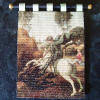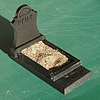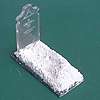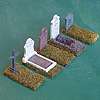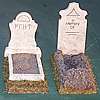| Contents | |||||||
 |
Icicles Adding icicles to a model. |
 |
Signs How to make removable signs for buildings. |
 |
Tapestries Making tapestries to add to a model. |
 |
Plastering
Walls Adding areas of plaster to model walls. |
 |
Damaged
Plaster How to make areas of damaged plasterwork. |
 |
Graves How to make a variety of graves. |
|
Gravestones Using old plant labels to make gravestones. |
||

|
Icicles (Click thumbnails for larger images) |
|||||
|
|
Stage 1 Cut strips from transparent plastic (acetate or blister pack) leaving a sawtooth edge. |
|
Stage 2 Attach in place with clear epoxy resin adhesive. |
|
Stage 3 Cover with more epoxy to build 3D icicles. |
|
Removable Signs (Click thumbnails for larger images) |
|||||
|
|
Removable Signs (Click thumbnails for larger images) |
||||
|
|
Materials: Blister Pack Plastic Card / Basswood (Printer) (Spray Glue) Superglue |
Stage 1 Decide how big your sign will be and draw the shape onto some thick card or thin basswood. Carefully cut the outline with a sharp craft knife. |
Stage 2 You can paint the design onto the sign if you like. I made a design on the computer, printed it, and stuck it onto the basswood using spray glue. This prevents the paper wrinkling up. |
||
|
Stage 3 Cut a piece of clear plastic from a blister pack. This should be just less than the width of the sign. Score a line with the back of the knife, and bend the plastic into an L-shape. |
Stage 4 Fix the plastic bracket to the back of the sign with superglue, and trim any excess length with the craft knife. The sign should now sit on the lower wall of a building with separate storeys. |
Stage 5 The finished sign in position over the door of my alchemist's shop. The sign can now be removed for transportation or storage, or replaced with a different sign to represent a different shop. |
|||
|
Damaged Plaster Walls (Click thumbnails for larger images) |
|||||
|
Step 1 Undercoat the model, and finish painting the area which will be exposed by the damage. Pinch a piece of kitchen foil, making a suitable random shape with a handle to hold it. |
Step 2 Spread the filler as described above, holding the "handle" of the foil to keep it in place. |
Step 3 Leave the filler to set for about 10 minutes, then carefully remove the foil. |
|||
|
Step 4 If you aren't happy with the shape of the hole, use a cocktail stick to remove some more of the filler. |
Step 5 Once the filler is dry, use a dental pick or other sharp tool to make some cracks around the edges of the hole. |
Step 6 Paint the wall plaster in the colour of your choice. Finish by painting the cracks and edges of the hole in a grey colour. |
|||
|
Gravestones from Plant Labels (Click thumbnails for larger images) |
|||||
|
Materials & Equipment Plastic plant labels Craft knife Primer Paint & brushes |
Stage 1 Plastic plant labels degenerate with exposure to UV light. Here is an easy way to reuse them when they no longer function in the garden. Wash and dry the labels. Cut the top off each label with a craft knife. Lengths from around 19mm (3/4") to 25mm (1") look about right. |
Stage 2 Scratch some lines with the point of the knife to represent text on the stone. You can also add small chips and cracks to the edges to make the stones look old and worn. |
|||
|
|
Stage 3 Cut more lengths from the remaining label to make more stones. Trim the tops to make a variety of different designs. You can also add plinths made from more pieces of the label, spare sprue or other materials. |
|
Stage 4 Prime the pieces and paint in your choice of stone colours. |
|
Options Gravestones are often made from marble or granite, and are a great subject to try faux stone paint effects. |
|
Stargate Kawoosh (Click thumbnails for larger images) |
|||||
|
|
Materials: Suitable former Acetate Cling film Clear adhesive tape Clear epoxy adhesive Gloss varnish & blue ink |
Stage 1 Wrap a strip of acetate around a cylindrical former with a rounded top. Secure the acetate with clear tape. This is a small vacuum flask, but a standard aerosol cap could be modified with the addition of a dome made from modelling clay or foam. |
Stage 2 Wrap a couple of layers of cling film over the top of the former and covering the acetate. |
||
|
Stage 3 Smear clear epoxy adhesive over the cling film, working your way down from the top. Once you get close to the base, remove the piece from the former. |
Stage 4 Attach the piece to the base with more clear epoxy, and finish off any areas which were not covered before. |
Stage 5 Paint the whole surface with a mixture of gloss varnish with a little blue ink added to tint it. |
|||
Contact me with suggestions, comments or questions.
These articles are provided under this Creative Commons Licence:

















